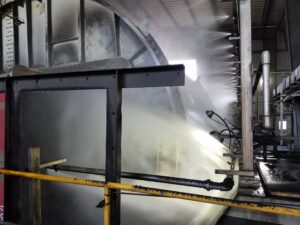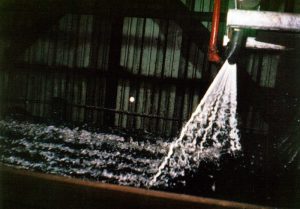Dust Control and Suppression Solutions: Different Bulk Material, Same Goal
Dust is a constant reality for bulk material handlers. As plants operate to provide products and solutions that support daily living and commerce, they inevitably generate dust that can escape and then travel wherever the air and its properties make it.
Fugitive dust can be released by any activity that disturbs bulk material throughout an operation, such as transporting by rail or truck, loading and unloading, crushing and chiseling, transferring by conveyor, and improper cleaning and maintenance. Storage piles can become primary dust sources as well.
If airborne dust is not restricted, it can cause health and safety risks, operational liabilities, and environmental problems. For example, fine respirable dust released by cement, fertilizer, and limestone can enter and remain in the lungs. Some dust also can develop into combustion or explosion hazards as it continues concentrating. Coal, wood, grain, and aluminum dust are just a few types that can explode or ignite.
Contributing to the challenge, the type of dust produced by a bulk material can vary even further at the plant. For instance, dust that begins as controllable and harmless can develop into a potentially harmful type later in processing.
Some operations may also undermine their efforts to contain dust by:
- Believing housekeeping is sufficient. A housekeeping program can help keep areas clean and unobstructed, but it is only a component of dust containment. In some cases, it might even worsen fugitive dust, such as by agitating it with air or steam.
- Not recognizing where the dust is coming from. dust can originate in hard-to-see or out-of-reach locations. If those sources are not identified and addressed, they can produce increasingly dangerous dust levels.
- Dependency on dust collectors. As with housekeeping, dust collectors contribute to containment, but they are only part of a complete solution. Dust collectors can still miss dust that gathers in overhead areas and on floors and machines.
Should fugitive dust become a growing problem, bulk material handling operators also can find themselves confronting the repercussions of OSHA inspections. OSHA’s standards identify that even 1/32″ of industrial dust can qualify as a risk.
The solution to these operational concerns is having access to versatile dust control and dust suppression systems specific to a bulk material in a particular industry.
Dust Control System for Any Industry
Bulk material handlers can make their production environments safer, cleaner, and more compliant by taking a multidimensional approach to dust. A total dust management plan will factor in the particular types, sizes, and sources of the facility’s dust, what methods contain it, and which control measures are available within the plant’s budget.
Such a dust control solution will involve a thorough assessment by skilled engineers. It also will include a customized plant-wide dust control plan that considers the entire facility. It further will ensure that production and housekeeping personnel have proper protective equipment such as masks, helmets, and goggles.
Specific components for a solution for controlling fugitive dust might include:
- transfer chutes designed and installed for the operation’s processing system, including the transfer tower, cascade conveyors, and post-crusher load zones
- a modular skirtboard and belt support system for properly aligned transfer points and centered loading with components such as inspection doors, internal wearliners, idlers, impact and support beds, and belt guards and cleaners
- a practical alternative to resolving off-center conveyor belt loading when a load zone chute replacement is not possible
- dry dust collectors that filter the air with low-pressure efficiency and no adverse effects according to industry standards
Dust Suppression Solution
For a dust control system, water and chemicals are standard strategic components of dust suppression.
For example, in a process known as wet dust extraction, a bifurcated fan generates energy to encapsulate dust particles into atomized water. This removes 99.7% of dust while eliminating the need for compressed air, belt maintenance, and bag changes.
Similarly, washdown systems remove dust after bulk material is conveyed. At the same time, they will minimize water usage while integrating drainage, curbing, and water shielding. This form of industrial dust suppression is much more efficient than hand-held hoses, which are typically cost- and labor-intensive. In addition, hoses are often ineffective in reaching areas that are hard to see or reach.
Dust suppression frequently involves chemical-solution injections that reduce and even eliminate dust, including systemic solutions such as managing materials that repel water from their surface. It will achieve this by lowering the water’s surface tension to a value closer to the treated material so the droplets can capture more dust particles.
A dust suppression solution’s chemical agents should be non-flammable, non-toxic, non-explosive, and biodegradable. When correctly formulated and applied, chemical dust suppression is recognized by the Environmental Protection Agency as the “Best Available Control Technology” for various material handling applications.
Chemical treatments for a bulk material handler’s specific dust suppression solution might include different agents for different objectives.
- Wetting Agents increase water’s ability to wet dust particles and suppress material emissions, thereby controlling dust with less mess and moisture. Wetting agent chemicals are particularly useful in rapid–material movement applications such as conveyor transfers, rotary cars, and bottom-dump rail car unloaders.
- Foam Agents combine foaming and wetting characteristics to allow easy mixing with water. Foam agents lower the required moisture for effective dust control and maximum BTU. Foam agents are commonly used in mining and transportation to reduce dust levels above and below the ground. They also are often applied to coal and other fine solids.
- Residual Agents prevent material from becoming dusty in storage. They also help control airborne dust created during conveying and decrease fugitive dust associated with stackout, stockpiles, railcar and hopper unloading feeders, and conveyor transfers.
Encrusting Agents create a semi-permanent shell over material for pile sealing, slope control, and rail car toppers. They guard against rain and air as well as wind erosion.
The proper agent will depend on the specific bulk material being treated for a particular industry. For example, a plant that handles biomass or limestone may require a foamable wetting agent for strongly hydrophobic (water-repelling) materials.
For coke, mining, wood chips, and transportation, bulk material may apply a concentrated surfactant blend used as a wetting agent to reduce dust levels occurring above and below the ground. The wetting agent should be engineered to allow treatment at fewer application points in the system to minimize water addition and reduce equipment and installation costs.
At a steel plant, the operators and their supporting engineers might determine that wet dust extraction with atomized mist will optimally solve a dust problem during production.
Inactive stockpiles at facilities handling coal, coke, and metallic ores will often apply a windproof, rain-resistant pile sealer that blends polymeric emulsion binding agents, surfactants, and recycled materials cellulosic products to reduce fugitive dust emissions as well as erosion.
Benetech: Your Ally in Bulk Material Handling
Whatever your bulk material handling mission might be, the engineers at Benetech understand your dust challenges and what you need to control them. Therefore, we welcome each opportunity to answer your questions about achieving a safer, more compliant, and productive operation.
If you would like to discuss greater dust control and suppression solutions for your operation – including application equipment start-up and training, system analysis, and annual management reports – contact us at (630) 844-1300 to speak with a specialist.
Posted in Dust Control, and Fugitive Dust Emissions






